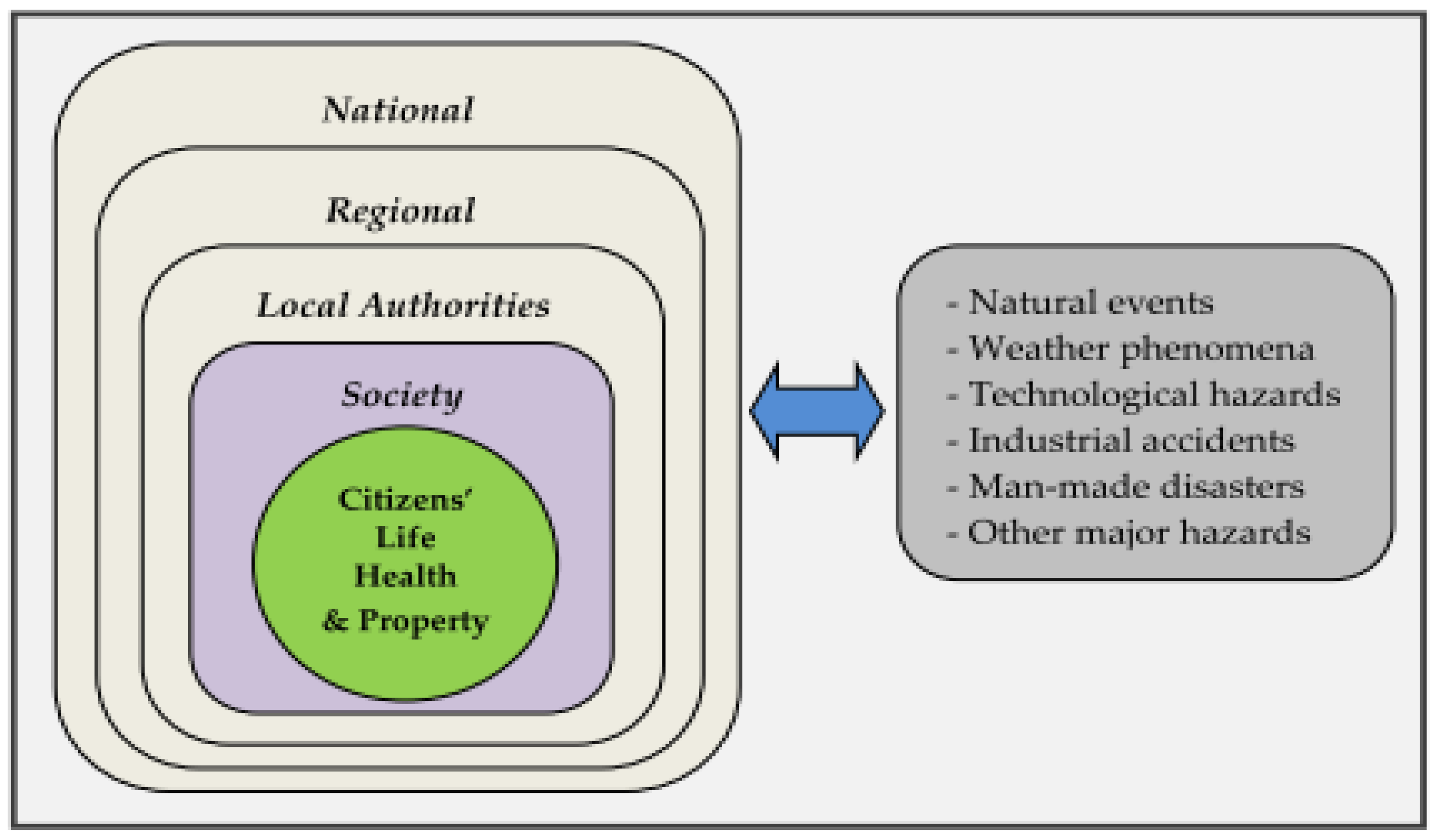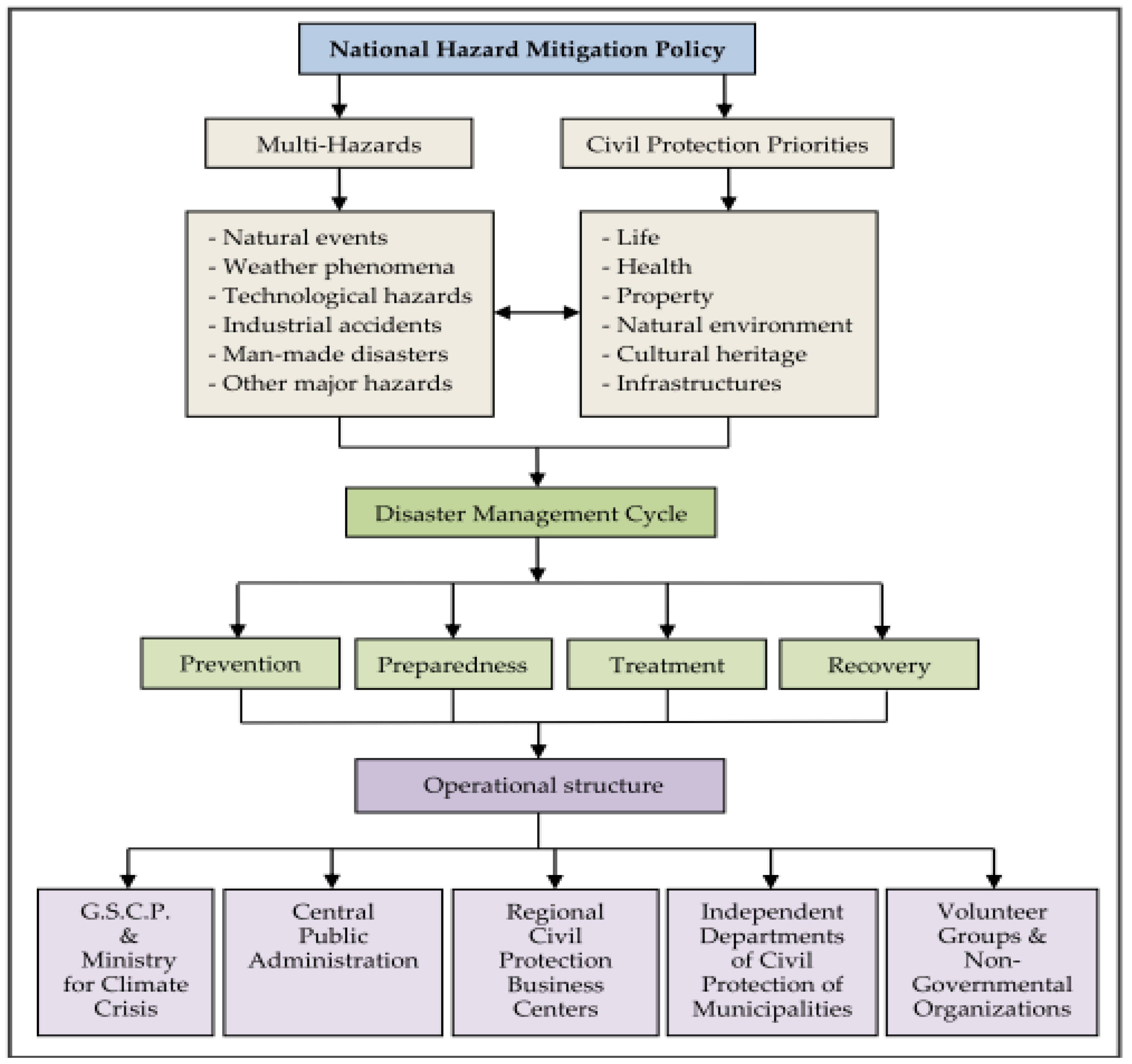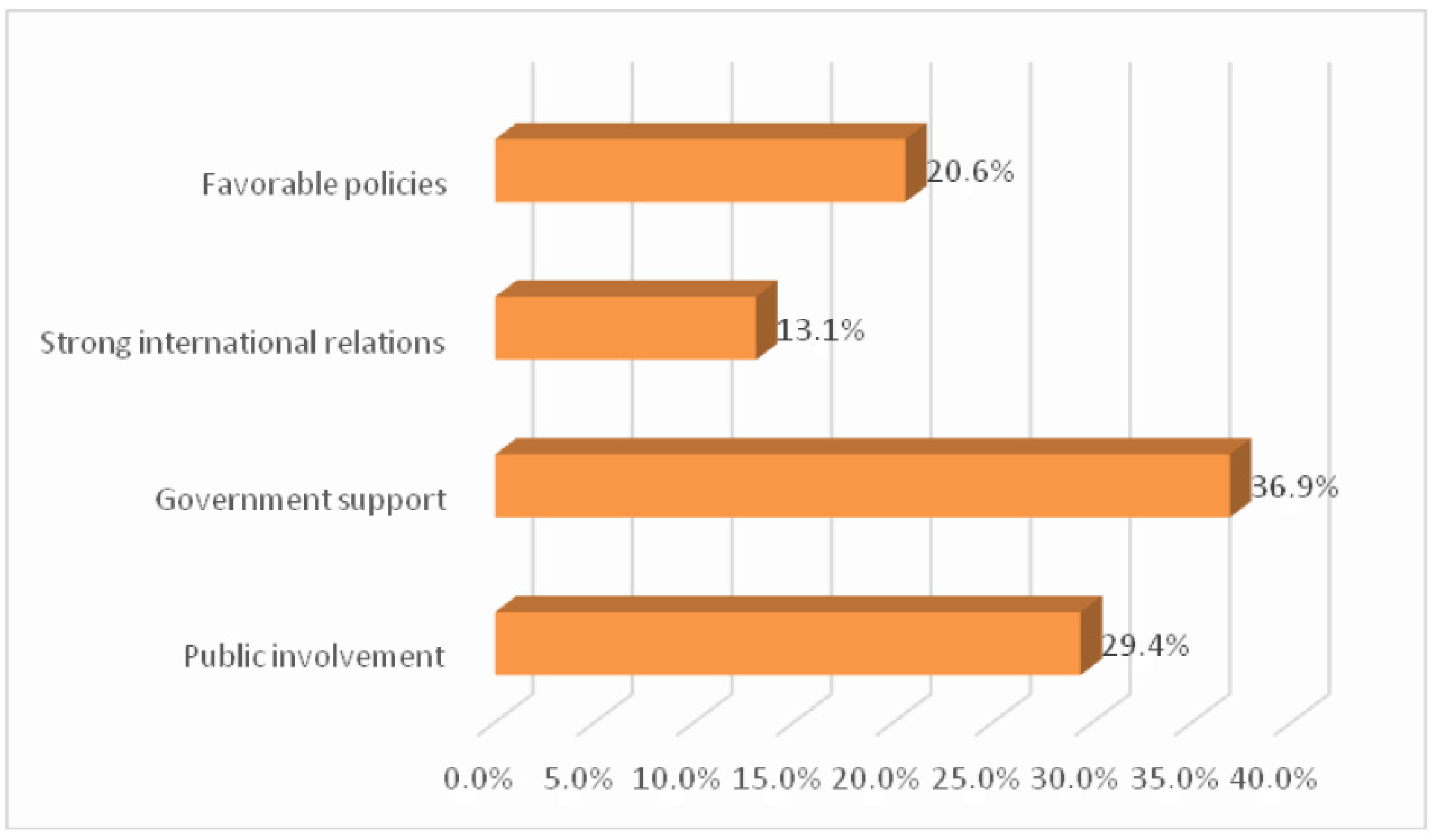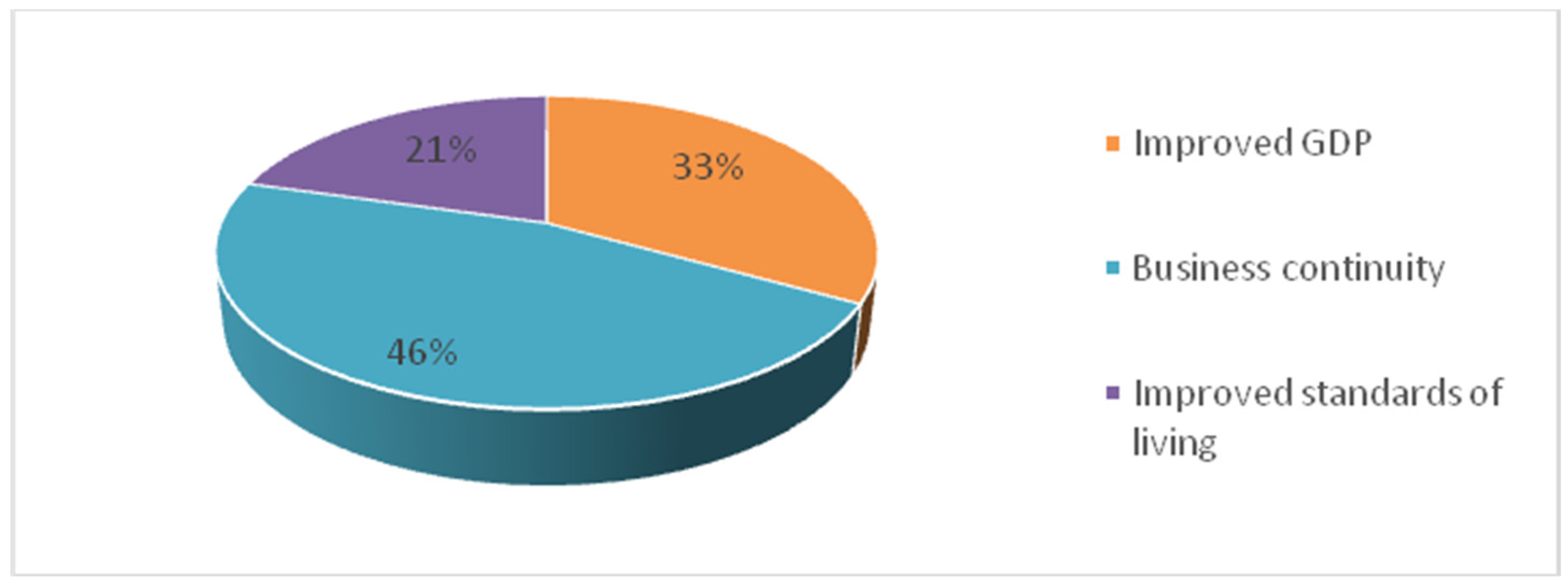Contribution of Civil Protection to the Urban Economy: Evidence from a Small-Sized Greek City
Abstract
:1. Introduction
1.1. Problem Statement
1.2. Purpose of the Study
- (1)
- What is the role of civil protection in economic recovery?
- (2)
- What are the key focus areas of civil protection?
- (3)
- What are the different strategies essential for improved civil protection?
1.3. Study Area
1.4. Literature Review
1.5. Civil Protection in Greece
1.6. Research Gap
2. Materials and Methods
2.1. Methodology
2.2. Research Design and Data Collection
2.3. Data Analysis
3. Results
3.1. Univariate Analysis
3.2. Descriptive Statistics
3.3. Chi-Square Analysis
4. Discussion
5. Conclusions
6. Recommendations
7. Areas for Future Research
Author Contributions
Funding
Institutional Review Board Statement
Informed Consent Statement
Data Availability Statement
Conflicts of Interest
References
- United Nations. A UN Framework for the Immediate Response to COVID-19. April 2020. Available online: un_framework_report_on_covid-19.pdf (accessed on 15 November 2021).
- Cook, A.D.B.; Dorussen, H. Civil Protection and Disaster Management. In The European Union’s Security Relations with Asian Partners; Christiansen, T., Kirchner, E., Tan, S.S., Eds.; Palgrave Macmillan: London, UK, 2021; pp. 185–207. [Google Scholar] [CrossRef]
- European Union. Humanitarian situation and needs. European Civil Protection and Humanitarian Aid Operations. July 2020. Available online: http://ec.europa.eu/echo/files/aid/countries/factsheets/greece_en.pdf (accessed on 15 November 2021).
- European Commission. Report from the Commission to the European Parliament and the Council on the Implementation of the EU Strategy on Adaptation to Climate Change. Brussels. COM/2018/738 Final. 2018. Available online: https://eur-lex.europa.eu/legal-content/ro/TXT/?uri=COM:2018:738:FIN (accessed on 17 November 2021).
- IPCC. Climate Change 2021: The Physical Science Basis. In Contribution of Working Group I to the Sixth Assessment Report of the Intergovernmental Panel on Climate Change; Masson-Delmotte, V., Zhai, P., Pirani, A., Connors, S.L., Péan, C., Berger, S., Caud, N., Chen, Y., Goldfarb, L., Gomis, M.I., et al., Eds.; Cambridge University Press: Cambridge, UK, 2021; Available online: https://www.ipcc.ch/report/sixth-assessment-report-working-group-i/ (accessed on 28 November 2021).
- Imperiale, A.J.; Vanclay, F. Barriers to enhancing disaster risk reduction and community resilience: Evidence from the L’Aquila disaster. Politics Gov. 2020, 8, 232–243. [Google Scholar] [CrossRef]
- Hermoso, J.C.R.; Luca, C.G. Civil society’s role in promoting local development in countries in transition: A comparative study of the Philippines and Romania. Int. Soc. Work 2006, 49, 319–332. [Google Scholar] [CrossRef]
- Chinkin, C. The Protection of Economic, Social and Cultural Rights Post-Conflict. United Nations Human Rights. The Office of High Commissioner 2007. pp. 1–57. Available online: https://www2.ohchr.org/english/issues/women/docs/Paper_Protection_ESCR.pdf (accessed on 2 December 2021).
- Sotiropoulos, D.A. Civil Society in Greece in the Wake of the Economic Crisis. Hellenic Foundation for European and Foreign Policy; Konrad Adenauer Stiftung: Athens, Greece, May 2014; Available online: http://www.eliamep.gr/wp-content/uploads/2014/05/kas.pdf (accessed on 2 December 2021).
- Sotiropoulos, D.A.; Huliaras, A.; Karadag, R. Greece Report. Sustainable Governance Indicators 2018; SGI. BertelsmannStiftung: Gütersloh, Germany, 2018; pp. 1–55. Available online: https://www.sgi-network.org/docs/2018/country/SGI2018_Greece.pdf (accessed on 2 December 2021).
- Hellenic Statistical Authority. Available online: https://www.statistics.gr/en/2011-census-pop-hous (accessed on 16 December 2021).
- Kozani Life. Available online: https://kozanlife.gr/2014/05/12/seismos-1995-kozani-66-rixter/ (accessed on 14 December 2021).
- Johns Hopkins Coronavirus Resource Center. Available online: https://coronavirus.jhu.edu/map.html (accessed on 16 December 2021).
- United Nations Framework Convention on Climate Change (UNFCCC). Adoption of the Paris Agreement. Proposal by the President. In Proceedings of the Paris Climate Change Conference, Paris, France, 30 November–11 December 2015; Available online: https://unfccc.int/resource/docs/2015/cop21/eng/l09.pdf (accessed on 10 December 2021).
- Baillie, J.; Zhang, Y.P. Space for nature. Science 2018, 361, 1051. [Google Scholar] [CrossRef] [PubMed] [Green Version]
- WWF. Available online: https://www.wwf.gr/climate-crisis (accessed on 23 October 2021).
- Union of Concerned Scientists. 1992 World Scientists’ Warning to Humanity. Available online: https://www.ucsusa.org/resources/1992-world-scientists-warning-humanity (accessed on 23 October 2021).
- Ripple, W.J.; Wolf, C.; Newsome, T.M.; Galetti, M.; Alamgir, M.; Crist, E.; Mahmoud, M.I.; Laurance, W.F. 15,364 scientist signatories from 184 countries. World Scientists’ Warning to Humanity: A Second Notice. BioScience 2017, 67, 1026–1028. [Google Scholar] [CrossRef]
- Ripple, W.J.; Wolf, C.; Newsome, T.M.; Barnard, P.; Moomaw, W.R. World Scientists’ Warning of a Climate Emergency. BioScience 2020, 70, 8–12. [Google Scholar] [CrossRef]
- IPCC. Summary for Policymakers. In Global Warming of 1.5 °C. An IPCC Special Report on the Impacts of Global Warming of 1.5 °C above Pre-Industrial Levels and Related Global Greenhouse Gas Emission Pathways, in the Context of Strengthening the Global Response to the Threat of Climate Change, Sustainable Development, and Efforts to Eradicate poverty; Masson-Delmotte, V., Zhai, P., Pörtner, H.-O., Roberts, D., Skea, J., Shukla, P.R., Pirani, A., Moufouma-Okia, W., Péan, C., Pidcock, R., et al., Eds.; Intergovernmental Panel on Climate Change, World Meteorological Organization: Geneva, Switzerland, 2018; p. 32. Available online: https://www.ipcc.ch/site/assets/uploads/sites/2/2018/07/SR15_SPM_version_stand_alone_LR.pdf (accessed on 10 December 2021).
- Murakami, H.; Levin, E.; Delworth, T.L.; Gudgel, R.; Hsu, P.C. Dominant effect of relative tropical Atlantic warming on major hurricane occurrence. Science 2018, 362, 794–799. [Google Scholar] [CrossRef] [PubMed] [Green Version]
- Ciavarella, A.; Cotterill, D.; Stott, P.; Kew, S.; Philip, S.; van Oldenborgh, G.J.; Skålevåg, A.; Lorenz, P.; Robin, Y.; Otto, F.; et al. Prolonged Siberian heat of 2020 almost impossible without human influence. Clim. Chang. 2021, 166, 9. [Google Scholar] [CrossRef] [PubMed]
- Earth Observatory. Available online: https://earthobservatory.nasa.gov (accessed on 23 October 2021).
- World Meteorological Organization. State of the Global Climate 2020. 2021, WMO-No. 1264. 1264. Available online: https://library.wmo.int/doc_num.php?explnum_id=10618 (accessed on 23 October 2021).
- World Health Organization. Available online: https://www.who.int/ (accessed on 23 October 2021).
- Ramli, M.W.A.; Alias, N.E.; Yusof, H.M.; Yusop, Z.; Taib, S.M. Development of a Local, Integrated Disaster Risk Assessment Framework for Malaysia. Sustainability 2021, 13, 10792. [Google Scholar] [CrossRef]
- Ministry of Environment & Energy. General Directorate for Environmental Policy, Directorate of Climate Change and Atmospheric Quality. National Climate Change Adaptation Strategy; Ministry of Environment & Energy: Athens, Greece, 2016.
- IPCC. Climate Change 2014: Synthesis Report. In Contribution of Working Groups I, II and III to the Fifth Assessment Report of the Intergovernmental Panel on Climate Change; Core Writing Team, Pachauri, R.K., Meyer, L.A., Eds.; IPCC: Geneva, Switzerland, 2014; 151p, Available online: https://www.ipcc.ch/site/assets/uploads/2018/05/SYR_AR5_FINAL_full_wcover.pdf (accessed on 10 December 2021).
- Steffen, W.; Rockström, J.; Richardson, K.; Lenton, T.M.; Folke, C.; Liverman, D.; Summerhayes, C.P.; Barnosky, A.D.; Cornell, S.E.; Crucifix, M.; et al. Trajectories of the Earth System in the Anthropocene. Proc. Natl. Acad. Sci. USA 2018, 115, 8252–8259. [Google Scholar] [CrossRef] [PubMed] [Green Version]
- IPBES. Global assessment report on biodiversity and ecosystem services of the Intergovernmental Science-Policy Platform on Biodiversity and Ecosystem Services. In The global Assessment Report on Biodiversity and Ecosystem Services; Brondízio, E.S., Settele, J., Díaz, S., Ngo, H.T., Eds.; IPBES Secretariat: Bonn, Germany, 2019; 1148p, ISBN 978-3-947851-20-1. [Google Scholar] [CrossRef]
- Miléř, T.; Marinič, P. Advances and Barriers to Education for Civil Protection in the Early 21st Century. In EDULEARN17 Proceedings; EDULEARN: Barcelona, Spain, 2017; pp. 6102–6106. [Google Scholar] [CrossRef]
- Gaetani, F.; Miozzo, D.; Parodi, A.; Siccardi, F.; Trasforini, E. The Structure, Role and Mandate of Civil Protection in Disaster Risk Reduction for South-Eastern Europe; South Eastern Disaster Risk Mitigation and Adaptation Programme; Administration of the Republic of Slovenia for Civil Protection and Disaster Relief, United Nations International Strategy for Disaster Reduction (UNISDR), World. 2009. Available online: https://www.unisdr.org/files/9346_Europe.pdf (accessed on 25 September 2021).
- OECD. Greece at a Glance: Policies for a Sustainable Recovery; Better Policies, Organisation for Economic Co-operation and Development Publishing; Better Policies, Organisation for Economic Co-Operation and Development Publishing: Paris, France, 2010. Available online: http://www.oecd.org/greece/44785912.pdf (accessed on 2 October 2021).
- Howard, K.; Bresnihan, S.; Mavhinga, D.; Chirwa, W.; Mayaya, B.; Winstanley, L. Space for Civil Society: How to Protect and Expand an Enabling Environment; CIDSE and Act Alliance Analysis and Recommendations: Brussels, Belgium, 2014; pp. 1–114. Available online: https://www.cordaid.org/en/wp-content/uploads/sites/3/2014/06/SpaceForCivilSociety.pdf (accessed on 25 September 2021).
- World Bank. Promoting Resilience Through Post-Crisis Recovery. In Knowledge Report, Proceedings of the 3rd World Reconstruction Conference, Brussels, Belgium, 6–8 June 2017; World Bank: Washington, DC, USA, 2018; 2203202020202072021; 220p, Available online: https://reliefweb.int/sites/reliefweb.int/files/resources/WRC3%20Proceedings%20and%20Knowledge%20Report%20FINAL.pdf (accessed on 7 October 2021).
- Hauri, A.; Kohler, K.; Roth, F.; Käser, M.; Prior, T.; Scharte, B. Risk and Resilience Report: Trend Analysis Civil Protection 2030: Uncertainties, Challenges, and Opportunities; Risk and Resilience Team Center for Security Studies (CSS): Zürich, Switzerland, 2020; 53p. [Google Scholar] [CrossRef]
- Diakakis, M.; Damigos, D.G.; Kallioras, A. Identification of Patterns and Influential Factors on Civil Protection Personnel Opinions and Views on Different Aspects of Flood Risk Management: The Case of Greece. Sustainability 2020, 12, 5585. [Google Scholar] [CrossRef]
- World Bank. Understanding the Needs of Civil Protection Agencies and Opportunities for Scaling up Disaster Risk Management Investments; Word Bank: Washington, DC, USA, 2021; Available online: https://openknowledge.worldbank.org/handle/10986/36292 (accessed on 7 October 2021).
- Ministry for Climate Crisis and Civil Protection. Available online: www.civilprotection.gr/en (accessed on 5 December 2021).
- Hellenic Parliament. National Mechanism for Crisis Management and Risk Management, restructuring of the General Secretariat for Civil Protection, Upgrading of the Voluntary Civil Protection System, Reorganization of the Fire Brigade and other Provisions. Law 4662/2020–Greek Government Leaflet 27/A/7-2-2020 (Articles 1–73). Available online: https://www.hellenicparliament.gr (accessed on 5 December 2021).
- European Committee of the Regions. Greece-Civil Protection. Available online: https://portal.cor.europa.eu/divisionpowers/Pages/Greece-Civil-protection.aspx (accessed on 5 December 2021).
- European Commission. European Civil Protection and Humanitarian Aid Operations. The National Disaster Management System of Greece. Available online: https://ec.europa.eu/echo/what/civil-protection/national-disaster-management-system/greece_en (accessed on 5 December 2021).
- Gobierno, P.D.E.L. Presidencia del gobierno 551. BoletinOficial del Estado número 285, de 28/11/1997. Ley 50/1997, de 27 de noviembre, del Gobierno. pp7. Available online: https://www.boe.es/buscar/doc.php?id=BOE-A-1997-25336 (accessed on 7 October 2021).
- Dorussen, H.; Madokoro, D.; Tago, A. Civil Protection. Enhancing Resilience through Collaboration. In EU-Japan Security Cooperation; Routledge: London, UK, 2018. [Google Scholar] [CrossRef]
- Drummond, K.; Murphey-Reyes, A. Quantitative Research Designs: Experimental, Quasi-Experimental, and Descriptive; Jones & Bartlett Learning: Burlington, MA, USA, 2017; pp. 155–183. [Google Scholar]
- Patel, P. Introduction to Quantitative Methods. Definition of Key Terms; Empirical Law Seminar: Cambridge, UK, 2009; 14p. [Google Scholar]
- Peersman, G. Overview: Data Collection and Analysis Methods in Impact Evaluation. Methodological Briefs: Impact Evaluation 10; UNICEF Office of Research: Florence, Italy, 2014; Available online: https://www.unicef-irc.org/publications/pdf/brief_10_data_collection_analysis_eng.pdf (accessed on 14 September 2021).
- Safe Kozani. Safe Kozani 2018—5th International Conference on Civil Protection & New Technology. 2018. Available online: www.safekozani.gr (accessed on 17 December 2021).
- Zacheilas, C.; Papadakis, N. An ongoing process? Greek Legislation and Regulatory Framework in Civil Protection: A Comparative Analysis of Pre and Post the 4662/2020 Law. Int. J. Arts Humanit. Soc. Sci. 2020, 1, 2555–2693. Available online: https://ijahss.net/assets/files/1604775265.pdf (accessed on 17 December 2021).
- Matsaganis, M. The Greek Crisis: Social Impact and Policy Responses; Friedrich-Ebert-Stiftung: Berlin, Germany, 2013; pp. 1–40. Available online: https://library.fes.de/pdf-files/id/10314.pdf (accessed on 17 December 2021).





| Characteristic | Frequency | Percentage (%) |
|---|---|---|
| Gender | ||
| Male | 113 | 70.6 |
| Female | 47 | 29.4 |
| Age bracket (Years) | ||
| Below 25 | 12 | 7.5 |
| 26–35 | 79 | 49.4 |
| 36–45 | 39 | 24.4 |
| Above 45 years | 30 | 18.7 |
| Education level | ||
| Certificate | 24 | 15.0 |
| Diploma | 26 | 16.3 |
| Bachelors | 61 | 38.1 |
| Masters | 35 | 21.9 |
| PhD | 14 | 8.7 |
| Employment status | ||
| Self-employed | 39 | 24.4 |
| Private sector employment | 68 | 42.5 |
| Public sector employment | 41 | 25.6 |
| Unemployed | 12 | 7.5 |
| Total | 160 | 100 |
| Economic Growth and Development | Strategies for Improved Civil Protection | Total | |||
|---|---|---|---|---|---|
| Public Involvement | Government Support | Strong International Relations | Favorable Policies | ||
| Improved GDP | 18 | 35 | 9 | 12 | 74 |
| Business continuity | 26 | 14 | 5 | 8 | 53 |
| Improved standards of living | 3 | 10 | 7 | 13 | 33 |
| Total | 47 | 59 | 21 | 33 | 160 |
| χ2 = 6.2534 | df = 3 | p =0.013 | a = 0.05 | ||
| Economic Growth and Development | Key Focus Areas of Civil Protection | Total | |||
|---|---|---|---|---|---|
| National Early Warning System | Public Safety | Crisis Preparedness Measures | Economy Rescue Operations | ||
| Improved GDP | 23 | 6 | 16 | 29 | 74 |
| Business continuity | 14 | 13 | 25 | 1 | 53 |
| Improved standards of living | 11 | 4 | 12 | 6 | 33 |
| Total | 48 | 23 | 53 | 36 | 160 |
| χ2 = 4.163 | df = 3 | p = 0.031 | a = 0.05 | ||
Publisher’s Note: MDPI stays neutral with regard to jurisdictional claims in published maps and institutional affiliations. |
© 2022 by the authors. Licensee MDPI, Basel, Switzerland. This article is an open access article distributed under the terms and conditions of the Creative Commons Attribution (CC BY) license (https://creativecommons.org/licenses/by/4.0/).
Share and Cite
Kalogiannidis, S.; Toska, E.; Chatzitheodoridis, F. Contribution of Civil Protection to the Urban Economy: Evidence from a Small-Sized Greek City. Sustainability 2022, 14, 981. https://doi.org/10.3390/su14020981
Kalogiannidis S, Toska E, Chatzitheodoridis F. Contribution of Civil Protection to the Urban Economy: Evidence from a Small-Sized Greek City. Sustainability. 2022; 14(2):981. https://doi.org/10.3390/su14020981
Chicago/Turabian StyleKalogiannidis, Stavros, Ermelinda Toska, and Fotios Chatzitheodoridis. 2022. "Contribution of Civil Protection to the Urban Economy: Evidence from a Small-Sized Greek City" Sustainability 14, no. 2: 981. https://doi.org/10.3390/su14020981
APA StyleKalogiannidis, S., Toska, E., & Chatzitheodoridis, F. (2022). Contribution of Civil Protection to the Urban Economy: Evidence from a Small-Sized Greek City. Sustainability, 14(2), 981. https://doi.org/10.3390/su14020981








